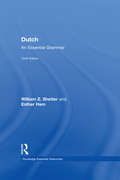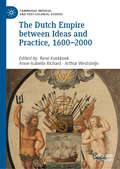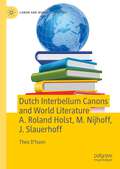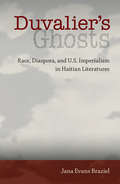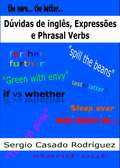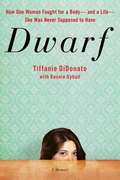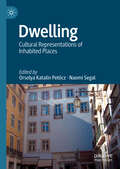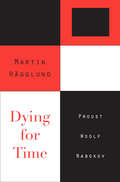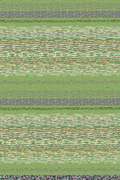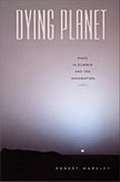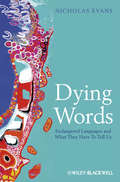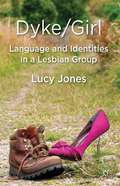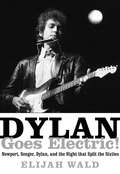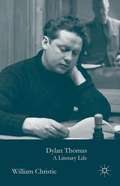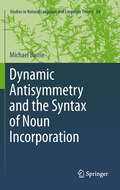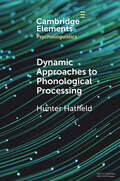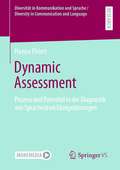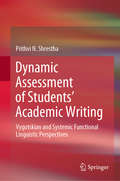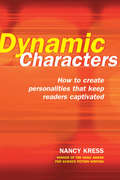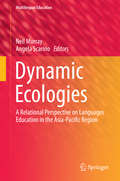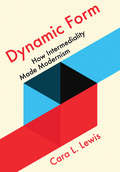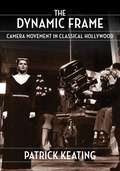- Table View
- List View
Dutch: An Essential Grammar (Routledge Essential Grammars)
by William Z. Shetter Esther HamNow in its 10th edition, Dutch: An Essential Grammar is a reference guide to the most important aspects of modern Dutch as it is used by native speakers. Features include: A brand new chapter on negation; A user-friendly style to ensure all elements of the language that are of particular difficulty to English speakers are adequately explained; ‘Let’s Try That’ sections in each chapter containing sample exercises; More examples and cross-referencing throughout, and a comprehensive glossary and index at the back of the book; Full use of examples given throughout illustrating modern usage. Dutch: An Essential Grammar is the ideal reference source both for those studying Dutch independently and for students in colleges, universities and adult classes.
The Dutch Empire between Ideas and Practice, 1600–2000 (Cambridge Imperial and Post-Colonial Studies Series)
by René Koekkoek Anne-Isabelle Richard Arthur WeststeijnThis volume explores the intellectual history of the Dutch Empire from a long-term and global perspective, analysing how ideas and visions of empire took shape in imperial practice from the seventeenth century to the present day. Through a series of case studies, the volume critically unearths deep-rooted conceptions of Dutch imperial exceptionalism and shows how visions of imperial rule were developed in metropolitan and colonial contexts and practices. Topics include the founding of the Dutch chartered companies for colonial trade, the development of commercial and global visions of empire in Europe and Asia, the continuities and ruptures in imperial ideas and practices around 1800, and the practical making of empire in colonial court rooms and radio broadcasting. Demonstrating the relevance of a long-term approach to the Dutch Empire, the volume showcases how the intellectual history of empire can provide fresh light on postcolonial repercussions of empire and imperial rule.Chapter 1, Chapter 3, Chapter 7 and Chapter 8 of this book are available open access under a CC BY 4.0 license at link.springer.com.
Dutch Interbellum Canons and World Literature A. Roland Holst, M. Nijhoff, J. Slauerhoff (Canon and World Literature)
by Theo D’haenThis text takes a wholly new look at a major early twentieth-century Dutch poet and novelist from the perspective of world literature, situating his work in both a national and a world literary context as measured against contemporaries and near-contemporaries such as Conrad, Pound, Brecht, Segalen, and Malraux. Exemplifying how an author from a “minor” literature may be a “major” world author, this book considers the debates within World Literature regarding the classification of literatures as ‘major’ and ‘minor’, canon formation within Dutch literature, Slauerhoff's position in the Dutch tradition as well as well as his contribution to world literature, particularly focusing on his East Asian poems, his East Asian novels and stories and his poetry and prose set in Latin America. This book is a key read for scholars and students of comparative literature, world literature, European literature, and Dutch literature. Lucid in style, innovative in approach, surprisingly fresh qua topic, this book opens new horizons for literary studies.
Duvalier's Ghosts: Race, Diaspora, and U.S. Imperialism in Haitian Literatures
by Jana Evans Braziel"Urgently pursues those nameless ghosts of Haitians lost in the liminal space of the Black Atlantic."--New West Indian Guide "Foregrounds the experiences of refugees (particularly those refused asylum and detained in camps), the political mobilization of the diaspora in the United States, the ramifications of the policies and adjustment programmes imposed on Haiti by the World Bank, the International Monetary Fund and USAID."--Bulletin of Latin American Research "Theoretically sound and well researched. Braziel has written a compelling book on the literatures of post-Duvalier Haiti."--Millery Polyne, New York University "A very original study, a tour-de-force that crisscrosses the disciplinary boundaries typically separating the social sciences and the humanities. It is richly researched, beautifully written, and will surely attract much critical attention and praise."--Valerie Kaussen, University of Missouri From a position of urgent political engagement, this provocative book offers novel and compelling interpretations of several well-known Haitian-born authors, particularly regarding U.S. intervention in their homeland. Drawing on the diasporic cultural texts of several authors, such as Edwidge Danticat and Dany Laferrière, Jana Evans Braziel examines how writers participate in transnational movements for global social justice. In their fictional works they discuss the United States’ many interventionist methods in Haiti, including surveillance, foreign aid, and military assistance. Through their work, they reveal that the majority of Haitians do not welcome these intrusions and actively criticize U.S. treatment of Haitians in both countries. Braziel encourages us to analyze the instability and violence of small nations like Haiti within the larger frame of international financial and military institutions and forms of imperialism. She forcefully argues that by reading these works as anti-imperialist, much can be learned about why Haitians and Haitian exiles often have negative perceptions of the U.S.
Dúvidas de Inglês, Expressões e Phrasal Verbs
by Sergio Casado Rodríguez Beatriz AntunesEste é um livro projetado para estudantes de nível intermediário de inglês que querem completar seu vocabulário com alguns phrasal verbs e expressões idiomáticas e para resolver dúvidas comuns que geralmente aparecem durante o aprendizado.
Dwarf: A Memoir
by Tiffanie Didonato Rennie DyballTiffanie DiDonato was born with dwarfism. Her limbs were extremely short preventing her from even reaching her own ears. To achieve independence, she underwent a series of painful bone-lengthening surgeries that gave her an unprecedented 14 inches of height--and the independence she never thought she'd have. After her surgeries, Tiffanie was able to learn to drive, to live in the dorms during college, and to lead a normal life. As a volunteer during the War in Iraq, she wrote to the men stationed abroad. Specifically, she became a pen pal to one of the Marines, and because of this relationship, he ultimately became her husband. In this book, she wrote: "It's okay with me if you picked up this book because you're curious about what it's like to live with dwarfism. But I hope that you'll take away much more--about freedom, finding independence, and adapting to the world when it won't adapt to you."
Dwelling: Cultural Representations of Inhabited Places
by Naomi Segal Orsolya Katalin PetőczDwelling is both an action and a location; it combines the spatial idea of habitation (dwelling in) with the temporal idea of lingering (dwelling on). We live not only in bricks and mortar, a tent, a hut or a spaceship, but also in that most changeful of forms, our body, or in a remembered or virtual home. Especially since COVID-19 we have seen changes in the topography of everyday life. In this multi-disciplinary collection, a complex of meanings is approached from a variety of specific, often personal angles.Framed by two longer essays which theorise how the psychology of home may change under sudden pressure and how social relations are embodied in windows, doors, walls and stairs, the book includes 18 further essays. Part I, ‘Informal settlements’, shows how a slum, urban development or nomadic life may create a self-sustaining identity; in Part II, ‘Huts and bridges’, impermanence shapes the state of dwelling, while Part III, ‘Liminal bodies’, presents bodies suspended at thresholds of change. Movement in time and space characterises the last three sections: Part IV, ‘Moving home’, depicts transitions and arrivals, Part V, ‘Dwelling in Memory’, focuses on recollections of past places and Part VI, ‘Are we there yet?’, points the way to a future in which the consulting-room changes to 2D, a family is exiled onto the small screen or we imagine breaking away altogether into outer space.
Dying for the Truth: The Concise History of Frontline War Reporting
by Paul MoorcraftThe role of war correspondents is crucial to democracy and the publics discovery of the truth. Without them, the temptation to manipulate events with propaganda would be irresistible to politicians of all hues.It starts by examining how journalists have plied their trade over the years most particularly from the Crimean War onwards. Their impact on the conduct of war has been profound and the author, an experienced journalist, explains in his frank and readable manner how this influence has shaped the actions of politicians and military commanders. By the same token the media is a potentially valuable tool to those in authority and this two-way relationship is examined.Technical developments and 24 hour news have inevitably changed the nature of war reporting and their political masters ignore this at their peril and the author examines the key milestones on this road.Using his own and others experiences in recent conflicts, be they Korea, Falklands, Balkans, Iraq or Afghanistan, the author opens the readers eyes to an aspect of warfare that is all too often overlooked but can be crucial to the outcome. The publics attitude to the day-to-day conduct of war is becoming ever more significant and this fascinating book examines why.
Dying for Time: Proust, Woolf, Nabokov
by Martin HagglundMarcel Proust, Virginia Woolf, and Vladimir Nabokov transformed the art of the novel in order to convey the experience of time. Nevertheless, their works have been read as expressions of a desire to transcend time-whether through an epiphany of memory, an immanent moment of being, or a transcendent afterlife. Martin Hägglund takes on these themes but gives them another reading entirely. The fear of time and death does not stem from a desire to transcend time, he argues. On the contrary, it is generated by the investment in temporal life. From this vantage point, Hägglund offers in-depth analyses of Proust’s Recherche, Woolf’s Mrs. Dalloway, and Nabokov’s Ada. Through his readings of literary works, Hägglund also sheds new light on topics of broad concern in the humanities, including time consciousness and memory, trauma and survival, the technology of writing and the aesthetic power of art. Finally, he develops an original theory of the relation between time and desire through an engagement with Freud and Lacan, addressing mourning and melancholia, pleasure and pain, attachment and loss. Dying for Time opens a new way of reading the dramas of desire as they are staged in both philosophy and literature.
Dying Modern: A Meditation on Elegy
by Diana FussIn Dying Modern, one of our foremost literary critics inspires new ways to read, write, and talk about poetry. Diana Fuss does so by identifying three distinct but largely unrecognized voices within the well-studied genre of the elegy: the dying voice, the reviving voice, and the surviving voice. Through her deft readings of modern poetry, Fuss unveils the dramatic within the elegiac: the dying diva who relishes a great deathbed scene, the speaking corpse who fancies a good haunting, and the departing lover who delights in a dramatic exit. Focusing primarily on American and British poetry written during the past two centuries, Fuss maintains that poetry can still offer genuine ethical compensation, even for the deep wounds and shocking banalities of modern death. As dying, loss, and grief become ever more thoroughly obscured from public view, the dead start chattering away in verse. Through bold, original interpretations of little-known works, as well as canonical poems by writers such as Emily Dickinson, Randall Jarrell, Elizabeth Bishop, Richard Wright, and Sylvia Plath, Fuss explores modern poetry's fascination with pre- and postmortem speech, pondering the literary desire to make death speak in the face of its cultural silencing.
Dying Planet: Mars in Science and the Imagination
by Robert MarkleyFor more than a century, Mars has been at the center of debates about humanity's place in the cosmos. Focusing on perceptions of the red planet in scientific works and science fiction, Dying Planet analyzes the ways Mars has served as a screen onto which humankind has projected both its hopes for the future and its fears of ecological devastation on Earth. Robert Markley draws on planetary astronomy, the history and cultural study of science, science fiction, literary and cultural criticism, ecology, and astrobiology to offer a cross-disciplinary investigation of the cultural and scientific dynamics that have kept Mars on front pages since the 1800s. Markley interweaves chapters on science and science fiction, enabling him to illuminate each arena and to explore the ways their concerns overlap and influence one another. He tracks all the major scientific developments, from observations through primitive telescopes in the seventeenth century to data returned by the rovers that landed on Mars in 2004. Markley describes how major science fiction writers--H. G. Wells, Kim Stanley Robinson, Philip K. Dick, Edgar Rice Burroughs, Ray Bradbury, Robert Heinlein, and Judith Merril--responded to new theories and new controversies. He also considers representations of Mars in film, on the radio, and in the popular press. In its comprehensive study of both science and science fiction, Dying Planet reveals how changing conceptions of Mars have had crucial consequences for understanding ecology on Earth.
Dying to be English: Suicide Narratives and National Identity, 1721–1814 (Gender and Genre #8)
by Kelly McGuireThis study examines the presentation of suicide within the genre of the eighteenth-century novel. Referencing several key writers of the period, McGuire demonstrates that their work inscribes a nationalist imperative to frame suicide as self-sacrifice.
Dying Words
by Nicholas EvansThe next century will see more than half of the world's 6,000 languages become extinct, and most of these will disappear without being adequately recorded. Written by one of the leading figures in language documentation, this fascinating book explores what humanity stands to lose as a result.Explores the unique philosophy, knowledge, and cultural assumptions of languages, and their impact on our collective intellectual heritageQuestions why such linguistic diversity exists in the first place, and how can we can best respond to the challenge of recording and documenting these fragile oral traditions while they are still with usWritten by one of the leading figures in language documentation, and draws on a wealth of vivid examples from his own field experienceBrings conceptual issues vividly to life by weaving in portraits of individual 'last speakers' and anecdotes about linguists and their discoveries
Dyke/Girl: Language and Identities in a Lesbian Group
by Lucy JonesThis book explores the construction of identities within a lesbian group, outlining interactive tactics used in the production of mutually-negotiated norms of authenticity. Using ethnography and discourse analysis, a range of group-specific personae are revealed to be continually reworked and reproduced within the women's interaction.
Dylan Goes Electric!: Newport, Seeger, Dylan, and the Night that Split the Sixties
by Elijah WaldTHE INSPIRATION FOR THE MAJOR MOTION PICTURE A COMPLETE UNKNOWN. One of the music world’s pre-eminent critics takes a fresh and much-needed look at the day Dylan “went electric” at the Newport Folk Festival.On the evening of July 25, 1965, Bob Dylan took the stage at Newport Folk Festival, backed by an electric band, and roared into his new rock hit, Like a Rolling Stone. The audience of committed folk purists and political activists who had hailed him as their acoustic prophet reacted with a mix of shock, booing, and scattered cheers. It was the shot heard round the world—Dylan’s declaration of musical independence, the end of the folk revival, and the birth of rock as the voice of a generation—and one of the defining moments in twentieth-century music.In Dylan Goes Electric!, Elijah Wald explores the cultural, political and historical context of this seminal event that embodies the transformative decade that was the sixties. Wald delves deep into the folk revival, the rise of rock, and the tensions between traditional and groundbreaking music to provide new insights into Dylan’s artistic evolution, his special affinity to blues, his complex relationship to the folk establishment and his sometime mentor Pete Seeger, and the ways he reshaped popular music forever. Breaking new ground on a story we think we know, Dylan Goes Electric! is a thoughtful, sharp appraisal of the controversial event at Newport and a nuanced, provocative, analysis of why it matters.“In this tour de force, Elijah Wald complicates the stick-figure myth of generational succession at Newport by doing justice to what he rightly calls Bob Dylan’s ‘declaration of independence’ . . . This is one of the very best accounts I’ve read of musicians fighting for their honor.” — Todd Gitlin, author of The Sixties and Occupy Nation
Dylan Thomas
by William ChristieDylan Thomas: A Literary Life offers an accurate and unsensationalized account of the poet's life in the context of British and American literary culture in the first half of the twentieth century, along with a critical reading of a selection of characteristic works in the many different genres in which Dylan Thomas worked, from the dense and rhetorically powerful lyrics which established his reputation through his stories and radio and film scripts to the triumphant 'play for voices', Under Milk Wood. This study is designed to close what has been called 'the yawning gap' between Thomas's popular and critical reputations, and is a major contribution to the revival and revision of the poet's work and reputation.
Dynamic Antisymmetry and the Syntax of Noun Incorporation
by Michael BarrieThis innovative analysis of noun incorporation and related linguistic phenomena does more than just give readers an insightful exploration of its subject. The author re-evaluates--and forges links between--two influential theories of phrase structure: Chomsky's Bare Phrase Structure and Richard Kayne's Antisymmetry. The text details how the two linguistic paradigms interact to cause differing patterns of noun incorporation across world languages. With a solid empirical foundation in its close reading of Northern Iroquoian languages especially, Barrie argues that noun incorporation needs no special mechanism, but results from a symmetry-breaking operation. Drawing additional data from English, German, Persian, Tamil and the Polynesian language Niuean, this synthesis has major implications for our understanding of the formation of the verbal complex and the intra-position (roll-up) movement. It will be priority reading for students of phrase structure, as well as Iroquoian language scholars.
Dynamic Approaches to Phonological Processing (Elements in Psycholinguistics)
by Hunter HatfieldNatural language occurs in time. Events happen earlier, later, or simultaneously with other events; however, this temporal dimension is often downplayed or overlooked. This Element introduces readers with a background in structural linguistics to dynamic approaches to phonological processing. It covers models of serial order, speech production and speech perception, with special attention to how they can enhance one another. The work then asks whether dynamic approaches have the potential to change how we think of phonological structure. Key ideas discussed include phonemes and auditory targets, control mechanisms creating structure, and the shape of phonological representations in a dynamic context. The work should function as a bridge for those with linguistic questions who want to learn answers derived from the study of speech as a dynamic system.
Dynamic Assessment: Prozess und Potential in der Diagnostik von Sprachentwicklungsstörungen (Diversität in Kommunikation und Sprache / Diversity in Communication and Language)
by Hanna EhlertIn dieser Publikation wird Dynamic Assessment erstmalig im deutschsprachigen Raum zur Sprachdiagnostik mehrsprachiger Kinder im Kindergartenalter in einer Studie pilotiert. Dynamic Assessment ist eine alternative diagnostische Vorgehensweise im Bereich Kindersprache. Sie hat Potential, die tatsächlichen sprachlichen Kompetenzen bisher schwer zu diagnostizierenden Zielgruppen, wie mehrsprachige Kinder, zu erfassen. Durch ihren Fokus auf die situativen sprachlichen Lernfähigkeiten unterscheidet sie sich mit einem in die Zukunft gerichteten Blick von klassischen Diagnostikansätzen, welche lediglich den Status Quo sprachlicher Leistungen erfassen.
Dynamic Assessment of Students’ Academic Writing: Vygotskian and Systemic Functional Linguistic Perspectives
by Prithvi N. ShresthaThis book explores the application of an innovative assessment approach known as Dynamic Assessment (DA) to academic writing assessment, as developed within the Vygotskian sociocultural theory of learning. DA blends instruction with assessment by targeting and further developing students’ Zone of Proximal Development (ZPD).The book presents the application of DA to assessing academic writing by developing a set of DA procedures for academic writing teachers. It further demonstrates the application of Hallidayan Systemic Functional Linguistics (SFL), combined with DA, to track undergraduate business management students’ academic writing and conceptual development in distance education.This work extends previous DA studies in three key ways: i) it explicitly focuses on the construction of a macrogenre (whole text) as opposed to investigations of decontextualized language fragments, ii) it offers the first in-depth application of the powerful SFL tool to analyse students’ academic writing to track their academic writing trajectory in DA research, and iii) it identifies a range of mediational strategies and consequently expands Poehner’s (2005) framework of mediation typologies. Dynamic Assessment of Students’ Academic Writing will be of great value to academic writing researchers and teachers, language assessment researchers and postgraduate students interested in academic writing, alternative assessment and formative feedback in higher education.
Dynamic Characters
by Nancy KressIn teaching writers the fundamentals of creating characters that will keep their readers spellbound, Kress utilizes dozens of excerpts from well-known fiction, along with enlightening exercises.
Dynamic Ecologies
by Neil Murray Angela ScarinoThis volume provides a fascinating glimpse into the complex language ecologies of Southeast Asia. Adopting a relational perspective, it considers their significance for the region, its peoples, the policy and practice of language teaching, learning and assessment and the fate of local languages. It gives particular prominence to the relationship between English and Chinese, it's likely transformation at a time of significant global change and the impact that these two languages and their synergy will have on the place of other languages and dialects. Dynamic Ecologies: A Relational Perspective on Languages Education in the Asia-Pacific Region draws on the research and insights of key scholars in the field and provides case studies that illustrate the impact of relevant language policy in countries including Singapore, Malaysia, Hong Kong, South Korea and Australia.
Dynamic Fair Dealing
by Martin Zeilinger Rosemary Coombe Darren WershlerDynamic Fair Dealing argues that only a dynamic, flexible, and equitable approach to cultural ownership can accommodate the astonishing range of ways that we create, circulate, manage, attribute, and make use of digital cultural objects.The Canadian legal tradition strives to balance the rights of copyright holders with public needs to engage with copyright protected material, but there is now a substantial gap between what people actually do with cultural forms and how the law understands those practices. Digital technologies continue to shape new forms of cultural production, circulation, and distribution that challenge both the practicality and the desirability of Canada's fair dealing provisions.Dynamic Fair Dealing presents a range of insightful and provocative essays that rethink our relationship to Canadian fair dealing policy. With contributions from scholars, activists, and artists from across disciplines, professions, and creative practices, this book explores the extent to which copyright has expanded into every facet of society and reveals how our capacities to actually deal fairly with cultural goods has suffered in the process. In order to drive conversations about the cultural worlds Canadians imagine, and the policy reforms we need to realize these visions, we need Dynamic Fair Dealing.
Dynamic Form: How Intermediality Made Modernism
by Cara L. LewisDynamic Form traces how intermedial experiments shape modernist texts from 1900 to 1950. Considering literature alongside painting, sculpture, photography, and film, Cara Lewis examines how these arts inflect narrative movement, contribute to plot events, and configure poetry and memoir. As forms and formal theories cross from one artistic realm to another and back again, modernism shows its obsession with form—and even at times becomes a formalism itself—but as Lewis writes, that form is far more dynamic than we have given it credit for. Form fulfills such various functions that we cannot characterize it as a mere container for content or matter, nor can we consign it to ignominy opposite historicism or political commitment.As a structure or scheme that enables action, form in modernism can be plastic, protean, or even fragile, and works by Henry James, Virginia Woolf, Mina Loy, Evelyn Waugh, and Gertrude Stein demonstrate the range of form's operations. Revising three major formal paradigms—spatial form, pure form, and formlessness—and recasting the history of modernist form, this book proposes an understanding of form as a verbal category, as a kind of doing. Dynamic Form thus opens new possibilities for conversation between modernist studies and formalist studies and simultaneously promotes a capacious rethinking of the convergence between literary modernism and creative work in other media.
The Dynamic Frame: Camera Movement in Classical Hollywood (Film and Culture Series)
by Patrick KeatingThe camera’s movement in a film may seem straightforward or merely technical. Yet skillfully deployed pans, tilts, dollies, cranes, and zooms can express the emotions of a character, convey attitude and irony, or even challenge an ideological stance. In The Dynamic Frame, Patrick Keating offers an innovative history of the aesthetics of the camera that examines how camera movement shaped the classical Hollywood style.In careful readings of dozens of films, including Sunrise, The Grapes of Wrath, Rear Window, Sunset Boulevard, and Touch of Evil, Keating explores how major figures such as F. W. Murnau, Orson Welles, and Alfred Hitchcock used camera movement to enrich their stories and deepen their themes. Balancing close analysis with a broader poetics of camera movement, Keating uses archival research to chronicle the technological breakthroughs and the changing division of labor that allowed for new possibilities, as well as the shifting political and cultural contexts that inspired filmmakers to use technology in new ways. An original history of film techniques and aesthetics, The Dynamic Frame shows that the classical Hollywood camera moves not to imitate the actions of an omniscient observer but rather to produce the interplay of concealment and revelation that is an essential part of the exchange between film and viewer.
